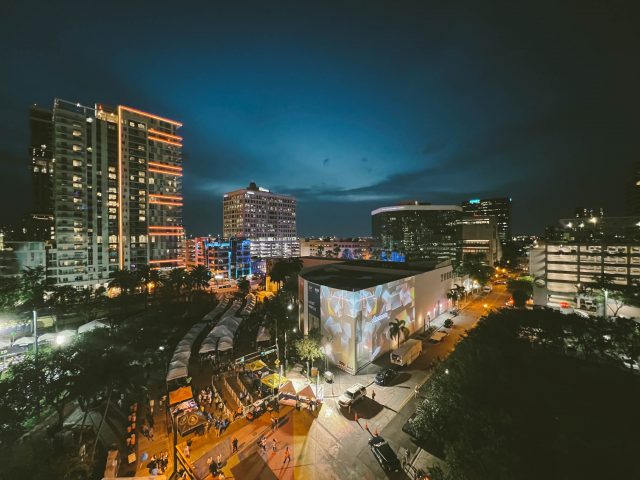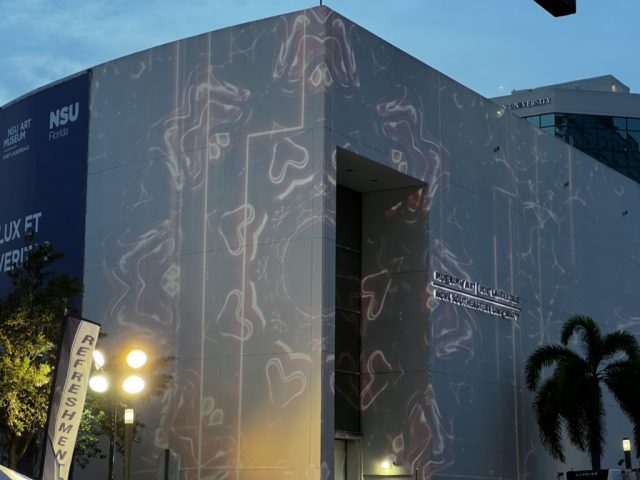

By Kristian Petrov Iliev
In early April, creatives from various realms collaborated to create and document a phenomenal work of art on the exterior of the NSU Art Museum Fort Lauderdale. Many elements came together: stunning projection art from Alessio Cassaro, incredible projectors from Panasonic Connect, permission to display the art on the exterior of the NSU Art Museum Fort Lauderdale, and videography from Yes We Are Mad, all proving how a space can almost instantaneously be animated. People stopped along the street to observe the graphics twirl and shimmer. Onlookers shared their thoughts about what they were seeing, and the bright patterns cast by the projectors added excitement to the evening.
At the VIP Party, the projection art impressed attendees and served as an easily accessible talking point for guests getting to know one another for the first time. Becoming part of the skyline, the art also looked like it belonged on the walls of the museum. In the same ways the sheen of certain building materials or coatings visually convey completion without taking away from the form, the result was expressive. This is the quiet beauty all masterpieces have: They are, simply, because they must be.
The effect the projection had on viewers in Fort Lauderdale was not a novelty. Widespread appreciation of this art form is already happening, and evidence of how it will continue to be a commissioner favorite and succeed in the future is already available:
Experiential art can often involve many people
Throughout the history of engraving and printmaking, many individuals played a role in the creation and reproduction of plates and prints. During the 21st century, artists often collaborate with teams of people to help much experiential art be produced. From audio technicians, designers, licensing agents, and fabricators, to lighting professionals, lawyers, and painters, making high quality work frequently involves multiple experts in different fields focusing on one project. These projects have larger audiences due to the big networks of the people involved.
Audiences or observers frequently have a more direct relationship with projects that are accessible or designed for active appreciation.
Without needing to pay admission fees to visit galleries or museums, experiential art can sometimes be found in immediate and authentic ways. Visible from the streets and balconies in Fort Lauderdale, CODAworx: The Art of Projection, Presented by Panasonic was free to enjoy. At lots of music, food, art, and government-sponsored festivals, people can often experience an art project for free or without paying a fee in addition to the one already paid to enter. Conferences, concerts, and other events are also incorporating experiential projects which increase the options to engage with content or art.
The usage of technology
Technology interests lots of people, and the usage of technology in numerous experiential art projects is an appeal to many in and of itself. Curiosity exists about how and why things work, and experiential art capitalizes on this.
One of the biggest lessons we learned from CODAworx: The Art of Projection, Presented by Panasonic was how inspiring experiential art can be. Evolving faster than artistic movements of the past thanks to the large number of creatives and technologies devoted to practicing, critiquing, and enjoying it, this form of art generates zest - something other forms of art often fail to do. The popularity of these works should continue to expand, as they represent many of the dreams of those who cherish art and those who make it.

